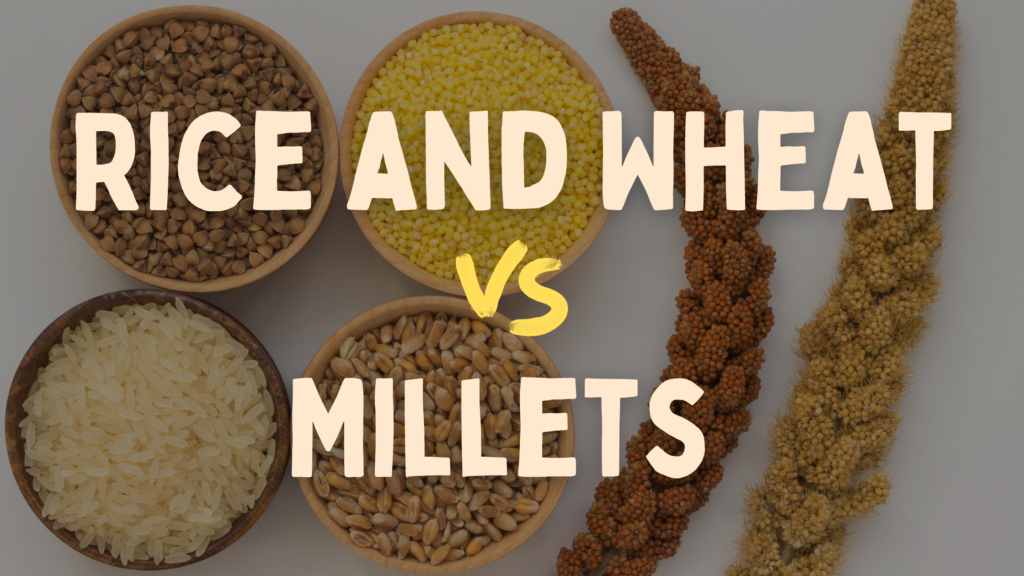
Introduction:
Regarding nutritional selections, there is a continuous discussion about which staple grains are best. Worldwide, rice and wheat have historically dominated dishes. However, millets have become more popular as a wholesome and long-term substitute in recent years. It’s essential to comprehend the subtle differences between different grains in order to make wise dietary choices. We’ll compare millets, rice, and wheat in this blog article and look at a number of elements that affect preferences.
Nutritional Value:
Millets—which include sorghum, finger millet, and pearl millet—have remarkable nutritional profiles. They are high in vitamins, minerals, calcium, iron, and magnesium, as well as dietary fiber, protein, and other nutrients. Millets, as compared to refined grains like white rice and wheat flour, keep their bran and germ, which offers vital nutrients. Furthermore, millets are a better option for people who are controlling their blood sugar levels or looking for a prolonged energy release because they have a lower glycemic index than wheat and rice.
Despite being staple grains in many cuisines, rice and wheat have different nutritional profiles. Because brown rice keeps its bran and germ layers, it has higher levels of fiber and micronutrients than white rice. As whole wheat flour contains both wheat germ and bran, it also retains more nutrients than refined wheat flour. But several vitamins and minerals that are abundant in millets are absent from both rice and wheat.
Cultural Significance and Culinary Diversity:
Rice and wheat are important cultural staples in many parts of the world. They are the basis for many classic recipes, including as sushi, biryani, and bread in addition to pasta and bread. Wheat and rice combine to create a culinary diversity that appeals to a wide range of tastes and preferences around the world.
While millets are not as common in many cultures, they have long been a staple of meals in portions of Asia and Africa. They are a common ingredient in African porridges, Indian roti, and alcoholic drinks like beer and spirits. The recent interest in millets has sparked the development of creative recipes and gourmet creations that highlight their flexibility and versatility in contemporary cooking.
Environmental Impact and Sustainability:
One of the key considerations in choosing grains is their environmental footprint. Millets possess several advantages in this regard. They are hardy crops that require minimal water and can thrive in poor soil conditions, making them well-suited to arid regions. Additionally, millets are often grown using traditional farming practices, reducing reliance on synthetic fertilizers and pesticides.
Rice and wheat cultivation, particularly in monoculture systems, can be resource-intensive and contribute to environmental degradation. Water-intensive rice paddies, for instance, can lead to water scarcity and soil salinization. Wheat cultivation, especially when reliant on intensive farming methods, may contribute to soil erosion and biodiversity loss.
Health Considerations:
For individuals with specific dietary requirements or health conditions, the choice between grains can have significant implications. Those with gluten sensitivities or celiac disease must avoid wheat products, opting instead for gluten-free alternatives like millets. Similarly, individuals managing diabetes or seeking weight management may benefit from incorporating millets into their diets due to their lower glycemic index and higher fiber content. Want to Which Type of millets is better for you? Check out or blog on Polished and Unpolished Millet: Click Here.
Millets vs Rice or Wheat:
When compared directly, millets are superior to rice and wheat in a number of ways. They offer a wider range of vital nutrients, such as increased amounts of protein, fiber, and minerals, making them nutrient-dense. Additionally, millets are less harmful to the environment because they require less resources to cultivate and are frequently produced utilizing sustainable farming methods.
Nonetheless, because of their broad availability, cultural significance, and culinary versatility, rice and wheat continue to dominate diets worldwide. Although millets are becoming more and more popular, customers in other areas might not be as familiar with or able to obtain them.
Conclusion:
There is no universal solution to the millets vs. rice and wheat dispute. Every grain has a different nutritional composition, cooking potential, and environmental implications. While wheat and rice are still common foods in many diets, millets offer an appealing substitute, especially for people looking for a varied, wholesome, and sustainable food source. The choice between these grains may ultimately depend on personal health requirements, cultural customs, and environmental considerations. Investigating the adaptability of millets in addition to rice and wheat can result in a more nutrient-dense, well-balanced diet and help create a more sustainable food system in general.
